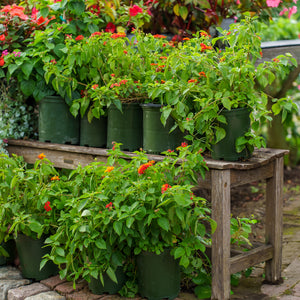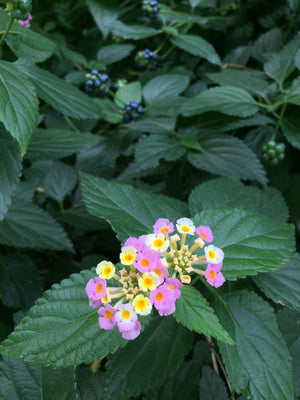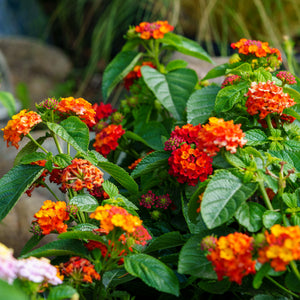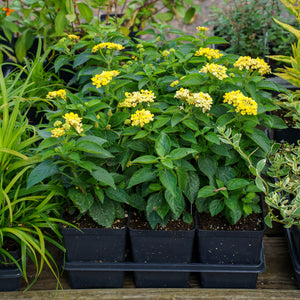The Lantana Guide
Lantana is a vibrant, sun-loving plant known for its clusters of bright flowers, heat tolerance, and pollinator appeal. Whether used in hanging baskets, borders, or large mass plantings, lantanas offer long-lasting color and are among the most drought-tolerant ornamental plants available. With both trailing and upright varieties in a spectrum of hues, lantana provides unmatched performance in summer landscapes.

About
Lantana belongs to the Verbenaceae family and is native to tropical regions of the Americas and Africa. While most garden lantanas are hybrids or cultivars of Lantana camara, other species like Lantana montevidensis provide trailing forms ideal for hanging baskets or groundcovers.
Their flowers are composed of small, tubular florets arranged in rounded clusters and often change color as they age. Foliage is typically coarse, dark green, and fragrant when brushed or crushed. Some popular cultivars include:
- 'Confetti' – A colorful mix of yellow, pink, and purple hues.
- 'Miss Huff' – A cold-hardy selection often perennial in southern climates.
- 'Bandana Lemon Zest' and 'Luscious Marmalade' – Upright, compact types with vivid coloring.
- 'Weeping White' and 'Purple Trailing' – Trailing forms excellent for cascading containers.
- 'Lucky Lavender' and 'Samantha' – Mounded habits with pastel or variegated foliage.
- Lantana montevidensis 'Trailing Lavender' – A spreading, lavender-blooming type ideal for erosion control or trailing over walls.

PLANTING
Lantana thrives in warm, sunny locations and is highly adaptable to various soil types:
- USDA Hardiness Zones: Perennial in Zones 8–11; grown as annuals elsewhere.
- Soil: Well-draining, moderately fertile soil. Avoid wet or compacted soils.
- Sunlight: Full sun is essential for heavy flowering and healthy growth.
- Spacing: Space 12–24 inches apart depending on variety size and growth habit.
- Planting Time: Plant outdoors after the last frost when nighttime temperatures are consistently above 55°F.
Lantana tolerates sandy or poor soils and thrives in hot, dry conditions, making it ideal for xeriscaping or coastal gardens.

CARE
Once established, lantana is low-maintenance and thrives on minimal attention:
- Watering: Water regularly during establishment. Once mature, lantana becomes drought tolerant and thrives on deep, infrequent watering.
- Fertilizing: Use a balanced slow-release fertilizer at planting. Avoid over-fertilizing, which can reduce blooms and promote excess foliage.
- Pruning: Deadhead regularly to encourage reblooming. In warm climates, prune hard in late winter or early spring to rejuvenate growth.
- Pest & Disease Management: Generally resistant to pests, though whiteflies and spider mites may appear in dry conditions. Good airflow and occasional rinsing can help.
Overwinter potted lantana indoors in colder zones, cutting back and storing in a bright, cool room until spring.

HOW TO USE
Lantana’s vivid colors, trailing options, and sun-loving nature make it an ideal choice for summer planting:
- Mass Plantings: Use upright cultivars like 'Bandana Lemon Zest' or 'Greg Grant' in drifts for maximum visual impact.
- Containers and Hanging Baskets: Choose trailing types like 'Purple Trailing' or Lantana montevidensis 'Alba' for cascading flower displays.
- Pollinator Gardens: Lantana attracts butterflies, bees, and hummingbirds with its nectar-rich blooms.
- Borders and Edges: Compact selections like 'Lucky Lavender' or 'Samantha' make neat, floriferous edging plants.
- Slopes and Retaining Walls: Trailing lantana helps prevent erosion and softens hardscapes.
Lantana pairs well with salvia, verbena, ornamental grasses, and heat-tolerant succulents in vibrant, sun-drenched plantings.

COMMON QUESTIONS
- Is lantana a perennial? Yes, in Zones 8–11. It is grown as an annual in colder zones.
- Is lantana poisonous to dogs? Yes, lantana is toxic to dogs if ingested and may cause vomiting, diarrhea, and liver issues.
- Is lantana poisonous to cats? Yes, lantana can be toxic to cats and should be kept out of reach.
- Do deer eat lantana? Lantana is generally deer resistant due to its aromatic foliage.
- Do rabbits eat lantana? Lantana is not a preferred food for rabbits and is typically left alone.
- How to propagate lantana? Take stem cuttings in summer and root in moist soil or water. Seeds can also be used but may not come true to type.
- When to prune lantana? Prune in early spring or late winter in warm climates. In colder zones, trim back in fall before overwintering indoors.
- Do hummingbirds like lantana? Yes, lantana is a strong attractant for hummingbirds, especially red, orange, and pink cultivars.
Conclusion
Lantana is a bold and resilient choice for hot, sunny gardens. Its continuous blooms, wide range of colors, and resistance to drought and pests make it a reliable performer from spring to frost. Whether you're creating pollinator havens, adding cascading color to containers, or designing low-maintenance landscapes, lantana brings brilliant rewards with very little effort.
The Lantana Collection
Sold Out
Sold Out
Sold Out
Sold Out





